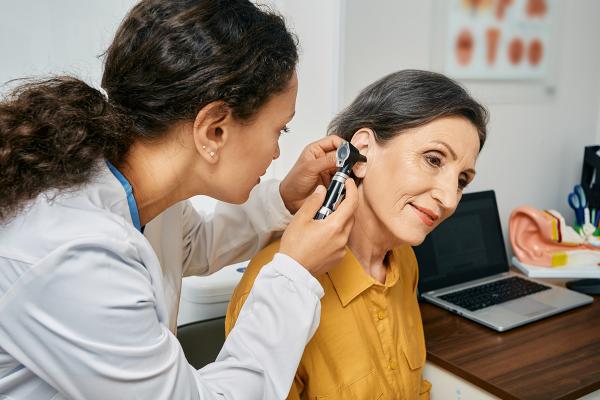
EPIC Hearing Healthcare helps members access hearing exams, hearing aids and more. Sign in to learn more and check eligibility.
Today's devices have a lot of cool features that fit your busy lifestyle and help you hear better. Here's what to know.

Is your hearing less sharp than it used to be? Maybe you’re always leaning in to hear the conversations in a crowded restaurant. Or you need to turn your phone’s volume way up to chat with your best friend. If so, hearing aids could be the answer.
But many people are reluctant to take that leap. In fact, only 1 in 3 older adults who could benefit from hearing aids actually wear them.1
That could be because they haven’t checked out hearing aids these days. You might be surprised to learn that many prescription models connect seamlessly to modern technology. And they look as sleek and stylish as the latest ear buds.
“Technology has improved by leaps and bounds in the last two years,” says Elizabeth Thompson, Au.D. She’s the president of Hickory Audiology in Bloomington, Indiana. “Hearing aids are multifunctional wonders that perform over 1 million operations per second.”
What does that mean for someone who has hearing loss? Sounds come through more sharply, so people can hear more clearly, Thompson explains. “The devices prioritize sounds that you want to hear versus unwanted background noise.”
Here is what to know about the latest advances in hearing aids — and how to take advantage of them.

EPIC Hearing Healthcare helps members access hearing exams, hearing aids and more. Sign in to learn more and check eligibility.
All hearings aids share some basic features. They have 3 parts:2
But hearing aids also vary widely in terms of style and features. For starters, you can choose from:2,3
Your hearing care professional will discuss the various hearing aid options with you. (Hearing care professionals, which includes audiologists, hearing aid dispensers and hearing instrument specialists, specialize in treating hearing loss.4)
They’ll help you select the one that is best for you based on:
For example, a hearing care professional may ask you where you have the most trouble hearing. Is it a concert or when you’re having a conversation? They may also ask where you spend most of your time. At work? Volunteering? At home?
Many people go for RIC hearing aids, says Thompson. “They’re very comfortable for patients. The piece that goes behind the ear is stable and stays in place, while the part that goes into the ear is small, so it doesn’t disrupt your good low-frequency hearing.”
Once you’ve settled on a preferred style, you will have multiple levels of technology to choose from, depending on your needs.
For instance, Relate®*, UnitedHealthcare Hearing’s brand, has different levels of technology, explains Jan Storhaug, Au.D. She’s the associate director, network and vendor relations, for UnitedHealthcare Hearing.
Here are some of the life-changing technologies to consider as you choose a pair of hearing aids.
Say goodbye to tiny batteries. No more running to the store to get them if you’ve used your last one. “Today’s hearing aids often have a rechargeable battery option,” says Thompson. “You simply place the hearing aids in a small charging case at night and they’re ready to go the next morning.”
Rechargeable models have become more popular for many reasons, including convenience.
People stay connected to the world nearly 24/7. And the latest hearing aids can help so you don’t miss a thing.
“They can connect to your phone so you can adjust them via an app or connect to audio coming from your phone,” says Thompson. “This means you can talk on the phone hands-free, hop on a Zoom call, listen to a podcast, or watch a TikTok video.” You can also connect to TVs and computers.
A big part of all that connectivity is Bluetooth.5 (Bluetooth is a wireless technology that lets devices connect with each other.) It’s available on both iPhones and Android devices.
Bluetooth-equipped hearing aids have many benefits, including:5
Some hearing aids come with a user-friendly smartphone app. It pairs with your hearing aids, so you can make real-time adjustments based on where you are.5 That means you can adjust to your preferred sound settings right from your phone screen.
For example, you may be able to change the settings at a favorite restaurant. Or at the office conference room. There may even be a basic setting for when you’re just relaxing at home.5
Another potential bonus with these apps? You may be able to connect with your hearing care professional via the app. “The app monitors how often you wear your hearing aids and the percentage of time you spend in certain environments,” Storhaug says. “This may make it easier for your provider to identify where you’re struggling and adjust your hearing aid as needed.”
This can sometimes be done remotely, without the need for an in-person appointment.
On an app, you may also be able to monitor battery life, the same way you do with your smartphone.
Today’s hearing aids are designed to be lived in — and are protected against moisture, says Thompson. “This means that it’s OK if they get wet in the rain or sweaty while you’re on a run or playing pickleball,” she says.
But in the end, what matters most is the quality of the sound. “It must be clean and crisp,” says Thompson. “If you’re not able to hear or understand what is being said, nothing else matters.”
Luckily, hearing aids no longer have to be expensive to achieve good sound quality. And that includes over-the-counter models.5 “There are great products on the market today at very reasonable price points,” says Thompson.
The bottom line: Work with your hearing care professional and determine which level of technology is right for you. Once you hit the sweet spot, you may find you want to use your hearing aids all the time.
If you’re a member of EPIC Hearing Healthcare, you get up to 3 follow-up visits at no extra cost — and a trial period to try out your new prescription hearing aids. Learn more.
Sources
Information is for educational purposes only and is not a substitute for the advice of a licensed medical provider. Consult your provider prior to making changes to your lifestyle or health care routine.
*Benefits, features, and/or devices vary by plan/area. Limitations, exclusions and/or network restrictions may apply.
Hearing aids purchased in the Silver technology level will receive 1 follow-up visit.
Relate® is a registered trademark of Ear Professionals International, LLC and is manufactured by Sonova. For assistance, if needed, or to report unexpected operations or events please contact Sonova at information.unitron@sonova.com.